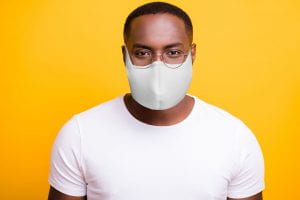 Nearly a year into the COVID-19 pandemic that has killed approximately 2 million people, wearing face masks in public has become the norm almost everywhere and a requirement in many places.
Nearly a year into the COVID-19 pandemic that has killed approximately 2 million people, wearing face masks in public has become the norm almost everywhere and a requirement in many places.
In the U.S., the Centers for Disease Control (CDC) recommended that Americans wear cloth face coverings in public after they learned that COVID-19 spreads via droplets produced when someone coughs, sneezes or even speaks, and that people can spread the virus without having any symptoms.
Since then, public health researchers have been studying whether face coverings do in fact help prevent the spread of COVID-19. A new systematic review published in December 2020 in the American Journal of Infection Control offers the most comprehensive evidence on COVID-19 and face masks to date.
The review includes six studies conducted in four countries: China, the U.S., Thailand and Bangladesh. All of the studies were case-controlled, meaning they compared participants who wore masks with those who did not. Five of the studies involved only healthcare workers, and the sixth involved participants from the general population. The participants in all of the studies were tested for COVID-19 over the course of their participation.
Combining all of the data, the researchers found that wearing a mask significantly reduced the risk of contracting COVID-19. Among healthcare workers, wearing a mask reduced the risk of infection by nearly 70 percent.
The CDC recommends everyone over the age of 2 wear a mask in public settings, including while on public transportation, while at stores, schools and workplaces or anytime you are around others outside of your household. In these situations, you should wear a mask and stay at least six feet apart from others. If someone in your household becomes infected with COVID-19, everyone who lives in the house should wear masks to avoid transmission of the virus.
The trick is, masks only reduce your risks if worn correctly. That means the mask needs to fit over your nose and mouth and snugly against the sides of the face. The mask should include multiple layers of fabric and be washable. It is important not to touch your mask and, if you do, to wash your hands afterwards. If you have to continually adjust your mask, it may not fit properly, and you might require a different mask type or brand.
When you take off your mask, handle it by the ear loops or ties. Fold the outside corners together and place it in the washing machine. Be careful not to touch your eyes, nose or mouth when removing your mask, and make sure you wash your hands immediately after removal.
The take-home message: Wearing a face covering when you are out in public can is an evidence-based practice that can protect you and help reduce the spread of the COVID-19.
Visit Cornell University’s Bronfenbrenner Center for Translational Research’s website for more information on our work solving human problems.



And why should we trust anything that comes out of China in regard to the pandemic given that they are not cooperating with the investigation into the origin of the virus and its spread in Wuhan??
Who paid for the study, what kind of masks were used and how is a real world study done on what we’ve been incessantly told is a pandemic…..with > a 99% survival rate?
In the studies, for how long were the masks worn (how many hours, 1 day or multiple days)? All adults? What activity did they engage in while wearing them? Indoor or outdoor and how many people were nearby and how close were they? How often did they touch their faces, touch their masks? How often did they wash their hands? What type of masks did they use and what were they made of? Were all the masks worn by participants the same types of masks? How often did they replace their current mask with a new one in order to reduce/prevent bacterial pneumonia? Did anyone lower their masks to sneeze, blow their nose, eat, etc at any point during the study? Were PCR tests calibrated for 45 cycles? If those performing the tests are aware that the PCR assays are not effective, what tests were they using to verify real infection in the test subjects? Etc. The general public is sorely underfed when it comes to actual facts and information, and treated like mindless sheep. I am just a regular college educated person and those were my first questions after reading this article. This is written for popular consumption and as usual, is therefore far too light on useful data. Thanks anyway. J. Mathew